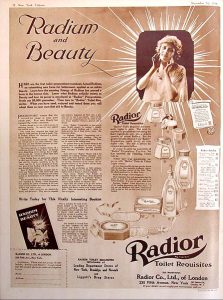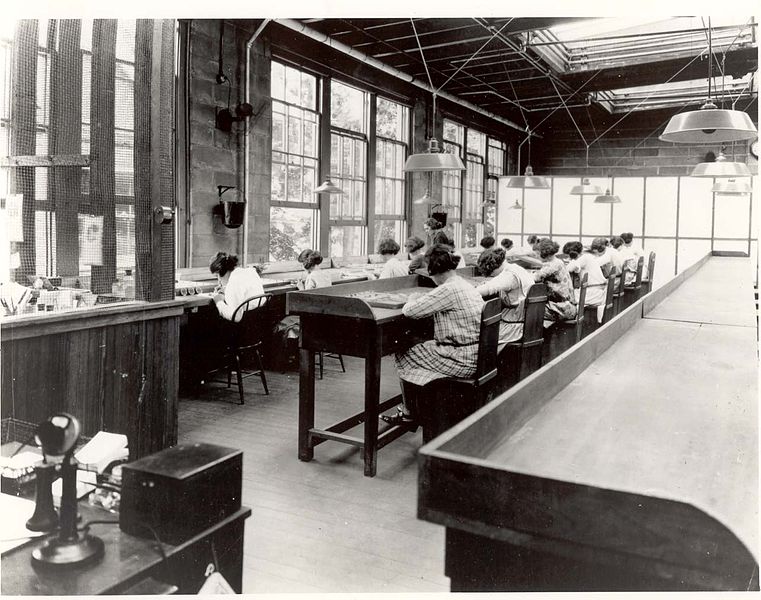In 1898, Marie and Pierre Curie, two of the most prominent pioneers in researching radioactivity, discovered the element radium. Radium was particularly intriguing because it glowed in the dark, and as Marie noted, “These gleamings seemed suspended in the darkness [and] stirred us with ever-new emotion and enchantment” (Moore).
Soon enough, the radium craze was on. After it was observed that radium could treat cancer, many people mistakenly thought it could also be used to treat other diseases as well. Before long, radium was widely considered a “miracle” substance, sold in pharmacies for all kinds of ailments. It was also widely believed that radium could prevent aging, and companies sold radium toothpaste, radium cosmetics, and even radium water.
The Radium Dials
Around this time, American inventor William J. Hammer went to Paris and obtained a sample of radium salt crystals from the Curies. Hammer discovered that by mixing the radium with glue and zinc sulfide, he could make glow-in-the-dark paint. His discovery would soon be used by the U.S. Radium Corporation to manufacture wristwatches with radium-painted dials. Advertisements for the product, which they called Undark, boasted of how it was all “made possible by the magic of radium!” U.S. Radium would also receive government contracts during World War I to produce watches and airplane instruments for American soldiers.

The corporation set up its factories in New Jersey and recruited dozens of young women to paint the watch dials. No safety precautions were taken, and the women were even encouraged to lick their brushes to keep the tip pointed and prevent the paint from drying. By the end of the day, the women themselves would be glowing from the radioactive paint on their clothes and skin. Harvard physiologist Cecil Drinker, who later investigated the factories, reported, “Dust samples collected in the workroom from various locations and from chairs not used by the workers were all luminous in the dark room. Their hair, faces, hands, arms, necks, the dresses, the underclothes, even the corsets of the dial painters were luminous. One of the girls showed luminous spots on her legs and thighs. The back of another was luminous almost to the waist.”
All along, the company assured the women that their work was perfectly safe. Within a few years, however, dozens of the women began showing signs of illness. The human body mistakes radium for calcium, so it filled their bones as calcium would, irradiating them from within. The victims had their bones break, teeth fall out, and spines collapse, and by 1927 more than 50 had died.
Initial attempts to receive compensation from U.S. Radium were futile. Medical and legal costs were enormous, and U.S. Radium was well defended by a team of lawyers and held a prominent position as government contractor. Nevertheless, the story of the so-called “radium girls” poisoning soon became a national sensation. Eventually, dial painter Grace Fryer filed a lawsuit along with four other women for damages of $250,000. In desperate need of money, they would eventually settle for $10,000 each and a $600 annual payment, although none of them would survive more than two years after the settlement.
Impact on the Manhattan Project

While the development of Undark was a catastrophe for the women who worked on it, it also served to disclose the dangers of radiation exposure. This was true even prior to the creation of the Manhattan Project. During his time working at Berkeley, nuclear chemist Glenn Seaborg noted in his diary, “As I was making the rounds of the laboratory rooms this morning, I was suddenly struck by a disturbing vision [of] the workers in the radium dial-painting industry” (Moore). Seaborg insisted that his scientific team further research the properties of plutonium and take appropriate safety precautions, regulations which would later extend to the Manhattan Project as well.
Louis Hempelmann, a doctor at Los Alamos, recalled how Manhattan Project safety regulations were also based on those of the radium dial factories, which were much improved by this time. Hempelmann recalled, “All of the doctors of the Manhattan Project went up to the radium dial painting plant up in Boston to see how they handle their—plutonium and radium are quite similar. They give off the same radiation… They had a hood or they worked under hoods, or something like that. They would clean it up and test the contaminated area for actual contamination. So our procedures were patterned after that.”
As one official from the Atomic Energy Commission would later note, “If it hadn’t been for those dial-painters, the [Manhattan] project’s management could have reasonably rejected the extreme precautions that were urged on it and thousands of workers might well have been, and might still be, in great danger” (Moore).
Legacy
Although U.S. Radium factory in New Jersey was the most infamous case of radium dial painting, it was far from the only one. It is estimated that by the 1920s as many as 4,000 workers were hired at companies across the United States and Canada to paint radium dials. Radium watches would continue to be manufactured until 1968, although the safety regulations were drastically improved.
The case of the radium girls would also have an impact on establishing strict guidelines for worker safety and compensation beyond the Manhattan Project. In 1949, the United States Congress passed a law which gave workers the right to receive compensation for occupational illnesses.





